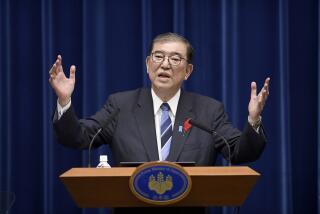Stage Is Set for Challenge to Japanese Power Structure : Politics: Prime minister dissolves Parliament’s lower house. This opens the way for a critical election Feb. 18.
- Share via
TOKYO — Prime Minister Toshiki Kaifu dissolved the lower house of Parliament today, setting the stage for a critical election next month that could compromise the conservative power structure that has ruled Japan for 35 years.
In a glaring symptom of weak leadership, Kaifu caved in to pressure from within his own party to dissolve the chamber only two days after it convened for the new year--without delivering his office’s annual policy speech.
The confused political scene is now expected to intensify in a campaign that will officially begin Feb. 3 and lead up to a general election set for Feb. 18. Although the public’s mood is ambivalent and difficult to read, the elections could develop into a plebiscite on Kaifu’s ruling Liberal Democratic Party.
There have been growing signs over the past year and a half that traditional supporters are losing their trust in the conservative, pro-American party, which has controlled Parliament since 1955.
The party has been crippled recently by a rigid and aging leadership, factional rivalry, a bungled attempt at tax reform, sex scandals and allegations of corruption. Last July, irate voters stung the LDP with its worst election setback ever, depriving the party of its majority in Parliament’s upper house by a large margin and putting conservative lower-house incumbents on the defensive.
It is too early to predict the ruling party’s chances of retaining the 257 seats needed to hold a majority in the 512-seat chamber. But Ichiro Ozawa, the party’s blunt-speaking secretary general, conceded Monday that only about 235 of the LDP’s approximately 330 candidates seem assured of winning. The party now holds 294 seats.
Ozawa declared a week ago that the Liberal Democrats would transfer power to an opposition coalition led by the Japan Socialist Party if they lose their majority, an apparent scare tactic aimed at appealing to the public’s desire for stability and continuity.
A more likely scenario, according to political analysts, would be for the Liberal Democrats to maintain power by recruiting members from among conservative independents in Parliament. If they lose too many seats for this tactic to succeed, a coalition with a centrist party such as the Buddhist-affiliated Komeito would allow the LDP to keep control.
While some kind of power-sharing arrangement may be necessary for the conservatives to maintain power in the lower house and tame the opposition-dominated upper house, few observers are betting that the opposition can form a coalition capable of wresting power from the ruling party.
“The Socialists don’t have the guts to antagonize the other opposition parties and run enough candidates to capture a majority,” said Takashi Inoguchi, a professor of political science at Tokyo University. “And they aren’t able to coordinate policy to form a joint campaign platform. They’re basically suspicious of the other opposition parties, regarding them as too close to the LDP.”
Indeed, the Socialist Party has been criticized for refusing to soften its defense policy. Despite the Socialists’ new aura of legitimacy, they still advocate gutting the U.S.-Japan military alliance, which many Japanese believe has provided a security umbrella for their postwar prosperity.
Ultimately, though, the coming elections may turn out to be more the story of an internal LDP power struggle than of a contest between the ruling party and the opposition.
The background is somewhat convoluted: Ruling party elders turned to Kaifu in desperation last August after failing to find a suitable candidate to succeed Sosuke Uno, a transitional leader who had been disgraced in a sex scandal.
Only a few weeks earlier, Uno had replaced Noboru Takeshita, who was forced to step down as prime minister because of his involvement in the Recruit influence-peddling scandal.
Yet by most accounts, Takeshita and a few other factional leaders still run the party from behind the scenes. One of Takeshita’s cronies, Shintaro Abe, a former foreign minister, demonstrated the Byzantine workings of the Liberal Democratic leadership last week by upstaging Kaifu’s much-ballyhooed tour of Eastern Europe.
Abe, who had been next in line to succeed Takeshita as prime minister before he, too, was embroiled in the Recruit scandal, met in Moscow with Soviet President Mikhail S. Gorbachev on the very day that Kaifu announced Japan’s aid package for Hungary and Poland.
Ironically, Kaifu had been cast in the role of party leader because party strategists hoped his clean and youthful image would reinvigorate the Liberal Democrats.
Kaifu returned to Tokyo last Thursday and quickly agreed, at a meeting with Takeshita, that the lower house would be dissolved today, without his delivering the traditional policy speech, according to Japanese press reports.
More to Read
Sign up for Essential California
The most important California stories and recommendations in your inbox every morning.
You may occasionally receive promotional content from the Los Angeles Times.













